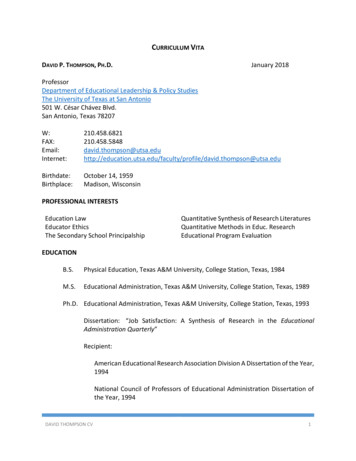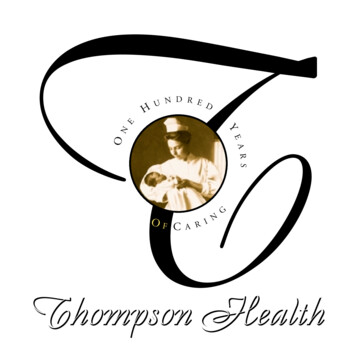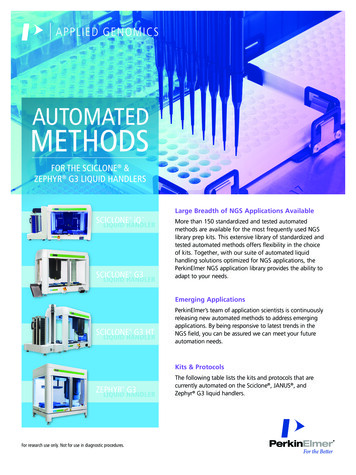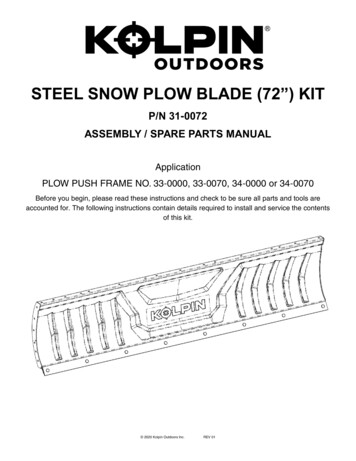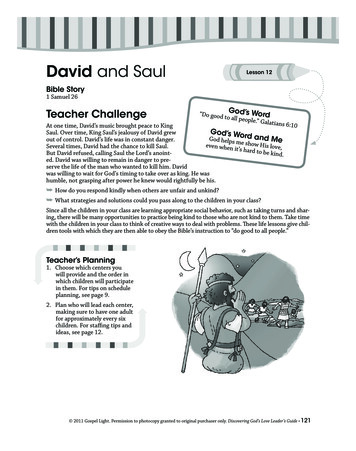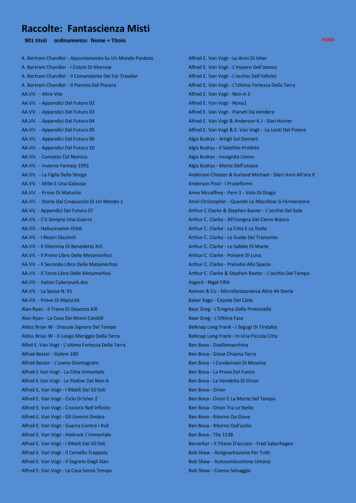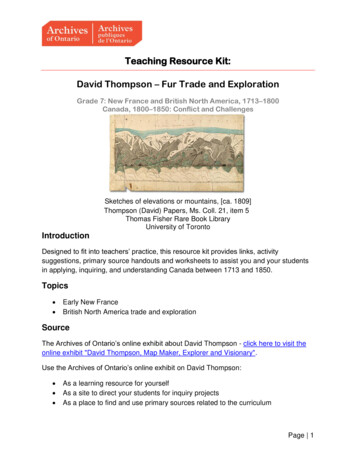
Transcription
Teaching Resource Kit:David Thompson – Fur Trade and ExplorationGrade 7: New France and British North America, 1713–1800Canada, 1800–1850: Conflict and ChallengesSketches of elevations or mountains, [ca. 1809]Thompson (David) Papers, Ms. Coll. 21, item 5Thomas Fisher Rare Book LibraryUniversity of TorontoIntroductionDesigned to fit into teachers’ practice, this resource kit provides links, activitysuggestions, primary source handouts and worksheets to assist you and your studentsin applying, inquiring, and understanding Canada between 1713 and 1850.Topics Early New FranceBritish North America trade and explorationSourceThe Archives of Ontario’s online exhibit about David Thompson - click here to visit theonline exhibit "David Thompson, Map Maker, Explorer and Visionary".Use the Archives of Ontario’s online exhibit on David Thompson: As a learning resource for yourselfAs a site to direct your students for inquiry projectsAs a place to find and use primary sources related to the curriculumPage 1
Themes that can be addressed Use of Primary SourcesFur trade companies and British fur tradersBritish fur traders and First Nations alliesFamilies of British fur tradersMapping the fur tradeSignificance of geographers for defining British North America, especially relatedto the Treaty of GhentCurriculum LinksStrand A. New France and British North America, 1713–1800Overall ExpectationsHistorical Thinking ConceptsSpecific ExpectationsA1. Application: Colonialand Present-day CanadaContinuity and Change;Historical PerspectiveA1.1, A1.2Historical Perspective;Historical SignificanceA2.4Historical Significance;Cause and ConsequenceA3.3, A3.4, A3.5, A3.6A2. Inquiry: From NewFrance to British NorthAmericaA3. UnderstandingHistorical Context: Eventsand Their ConsequencesStrand B. Canada, 1800–1850: Conflict and challengesOverall ExpectationsHistorical Thinking ConceptsSpecific ExpectationsB1. Application: Changesand ChallengesContinuity and Change;Historical PerspectiveB1.1B2. Inquiry: Perspectivesin British North AmericansHistorical Perspective;Historical SignificanceB2.3, B2.4B3. UnderstandingHistorical Context: Eventsand Their ConsequenceHistorical Significance;Cause and ConsequenceB3.4, B3.5Page 2
Assignment & Activity IdeasInquiring into the Fur Trade Drawing on the 2013 revised History curriculum, the historical inquiry processinvolves five steps: Formulating a question Gathering and organizing information or evidence Interpreting and analysing information or evidence Evaluating information or evidence and drawing conclusions Communicating findingsThe curriculum highlights that these steps do not have to be completedsequentially nor together. You may wish to explore specific steps based on yourstudents’ readiness and prior knowledge or your own resources and time. Seepages 22-24 in the 2013 revised Ontario Social Studies and History curriculumfor more details.Using a primary source handout from this Kit, introduce your students to the topicof David Thompson and the fur trade. Ask students to ask questions of theimage, Thompson and his experience, or the general topic of the fur trade. Usethese questions as jumping off points to explore these historical issues in moredepth.Use the David Thompson, Map Maker, Explorer and Visionary online exhibit as asource to point your students for their own inquiry project. Here, they can viewprimary sources and secondary information to gather and organize historicalinformation that they can interpret, evaluate, and communicate for different endproducts.One Source, Many Questions Using one of the primary source handouts found in this Teaching Kit, askstudents to identify the 5Ws (who, what, where, why, and when?) profiling thesource. The Identifying My Primary Source worksheet can help in this task.Ask students to zoom in on one of the aspects of the source they found strange,familiar, or interesting and identify them to the class. Write these things on theboard and group them according to theme.Use one or more of these themes as an introduction to an inquiry-basedassignment. Have students work in collaborative groups, individually, or as aclass as a short or long term project researching the historical context of theprimary source.Page 3
Mapping David Thompson Map David’s Thompson’s travels. Include primary sources found in this kit and onthe online exhibit as markers on places of significance.Alternatively, create a map of Upper and Lower Canada using David Thompsonrecords and modern pictures of the same place.Alternatively, ask students to create a Google map of the same area originallymapped by David Thompson. Comparing and contrasting the two maps, discusschanges in mapping methods. Do modern maps tell us new or differentinformation?Is David Thompson Significant? Ask students to develop criteria as to what makes someone or somethingsignificant enough for a memorial.Using the Ways to Remember David Thompson handout, ask students to createanother memorial for David Thompson.Alternatively, ask students to use the David Thompson memorial as a model tocreate a stamp and plaque for another figure in Canadian history or an explorerperson from today, such as Chris Hadfield.Page 4
Handouts & WorksheetsIntroduction to Primary Sources. 6Identifying My Primary Source . 7Trading Posts: Hudson’s Bay Company and Northwest Company (1820) . 8David Thompson’s Sketch of Mountains (1809) . 9David Thompson’s Travels . 10David Thompson’s Notebook . 11Treaty of Ghent Survey . 12Map of the North-West Territory of the Province of Canada (1814) . 13Ways to Remember David Thompson . 14Page 5
Introduction to Primary SourcesA selection of items from the David Thompson fonds,Carrie McGillivray fonds, and Cartographic Records CollectionArchives of OntarioA Primary Source is a document or object from the past created by people who livedduring that time. Primary Sources provide a view into an event or experience that onlypeople living during that time could have experienced.Archives collect and preserve primary sources so that students can learn history fromthe experiences of people who were there. At an archive, primary sources are calledrecords. At a museums, primary sources are called artifacts.Have you ever used a primary source before?Primary SourcesOriginal material from the pastExample:LettersDiariesPhotographsPaintings and other art workGraphsMapsSecondary SourcesMaterial people today write about the pastExample:TextbooksReference booksWebsites such as WikipediaCurrent news articlesDocumentaries and filmsWhat are some other examples of primary and secondary sources?Can sources be both primary and secondary?Page 6
Identifying My Primary SourceName of primary source:What type of primary source is it?What is happening in this primary source?Who created it?Why was it created?When was it created?Where was it created?What when you look at this source, is there anything strange about it?When you look at this source, is there anything familiar about it?What do you want to know about this primary source?What do you want to know about the people in the primary source?What is the most interesting thing about this primary source?Page 7
Trading Posts: Hudson’s Bay Company and Northwest Company(1820)Hudson’s Bay Company and Northwest CompanyForts at Île-à-la-Crosse, February 28, 1820Watercolour by George BackAcc. No. 1994-254-1.40RLibrary and Archives CanadaPage 8
David Thompson’s Sketch of Mountains (1809)Sketches of elevations or mountains, [ca. 1809]Thompson (David) Papers, Ms. Coll. 21, item 5 (?)Thomas Fisher Rare Book Library, University of TorontoPage 9
David Thompson’s TravelsMap Showing Thompson’s TravelsCartographic Computer Lab, #503802, National Geographic Image CollectionPage 10
David Thompson’s NotebookJournal No. 28, pp. 138-139 (1803-1831)David Thompson’s notebooks and journals, Reference Code: F 443-1Archives of OntarioHow would you keep track of your travels today?Page 11
Treaty of Ghent SurveyA Map of the Survey under the 6th Article of the Treaty of Ghent, signed by theCommissioners & c. & c., David Thompson, Astronomer & Surveyor.G. Matthews’ Lith., Montreal, [ca. 1826]Cartographic Records Collection, Reference Code: B-40-03Archives of OntarioPage 12
Map of the North-West Territory of the Province of Canada (1814)Map of the North-West Territory of the Province of Canada (1814)David Thompson fonds, Reference Code: F 443, R-C(U), AO 1541Archives of Ontario, I0030317Page 13
Ways to Remember David ThompsonDavid Thompson (1770-1857), issued 5 June 1957Designed by George Gundersen, engraved by Yves BarilCanadian Postal Archives, POS-424Library and Archives CanadaDavid Thompson 1770-1857Historic Sites and Monuments Board of Canada plaqueParks Canada, 2006Page 16
Ways to Remember David Thompson David Thompson (1770-1857), issued 5 June 1957 Designed by George Gundersen, engraved by Yves Baril Canadian Postal Archives, POS-424 Library and Archives Canada David Thompson 1770-1857 Historic Sites and Monuments Board of Canada plaque Parks Canada, 2006
![No, David! (David Books [Shannon]) E Book](/img/65/no-20david-20david-20books-20shannon-20e-20book.jpg)
